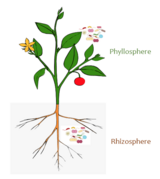Phycosphere
| Part of a series on |
| Microbiomes |
|---|
 |
The phycosphere is a microscale mucus region that is rich in
In terms of comparison, the phycosphere in
Phytoplankton-bacteria interactions
The
Interactions between phytoplankton and bacteria in the phycosphere could be potentially important in low-nutrient regions of the ocean and an example of mutualism. In marine
However, bacterial-phytoplankton interactions in the phycosphere could be
Also,
Examples of bacteria associated with phycosphere
In reality, the actual
- Pseudomonas
- Achromobacter
- Roseobacter
- Flavobacteraceae
- Alteromonadaceae
- Athrospira plantensis
- Terrimonas rubra
- C.vulgaris
- Sediminibacterium
- Chryseobacterium
See also
References
- ISBN 978-0-471-48529-2.
- S2CID 21278078.
- .
- S2CID 10055219.
5. Seymour, Justin R., et al. “Zooming in on the Phycosphere: the Ecological Interface for Phytoplankton–Bacteria Relationships.” Nature Microbiology, vol. 2, no. 7, 2017, pp. 1–13., doi:10.1038/nmicrobiol.2017.65.
6. Kim, B.-H., Ramanan, R., Cho, D.-H., Oh, H.-M., & Kim, H.-S. (2014). Role of Rhizobium, a plant growth promoting bacterium, in enhancing algal biomass through mutualistic interaction. Biomass and Bioenergy, 69, 95–105. doi: 10.1016/j.biombioe.2014.07.015
7. Geng, H., & Belas, R. (2010). Molecular mechanisms underlying roseobacter–phytoplankton symbioses. Current Opinion in Biotechnology, 21(3), 332–338. doi: 10.1016/j.copbio.2010.03.013 8. Ramanan, R., Kang, Z., Kim, B.-H., Cho, D.-H., Jin, L., Oh, H.-M., & Kim, H.-S. (2015). Phycosphere bacterial diversity in green algae reveals an apparent similarity across habitats. Algal Research, 8, 140–144. doi: 10.1016/j.algal.2015.02.003
9. Scharf, B. E., Hynes, M. F., & Alexandre, G. M. (2016). Chemotaxis signaling systems in model beneficial plant–bacteria associations. Plant Molecular Biology, 90(6), 549–559. doi: 10.1007/s11103-016-0432-4
